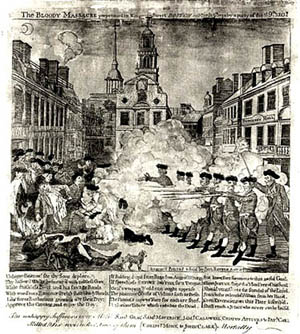
 |
Below the balcony of the Old Statehouse, a circle of cobblestones marks the spot where British soldiers fired on an angry mob and killed five people while wounding six others. This, the first bloodshed of what would become the Revolutionary War, occurred March 5, 1770.
Bostonians were already at verbal arms with the British due to the Stamp Act of 1765 and the Townshend Act (the famous "Tea Tax") of 1767. Anti-Stamp Act mobs had all but destroyed Royal Governor Thomas Hutchinson's house in protest. When John Hancock's ship Liberty was seized for smuggling in 1768, several customs collectors were beaten by a Boston Mob. To restore order, and to keep the taxes flowing, King George III sent regiments of his Redcoats to Boston.
The Redcoats became a symbol on which Bostonians vented their outrage with the crown. On March 5 there was a crowd being incited to a mob at Dock Square by, it is generally believed but not confirmed, Sam Adams. The speaker whipped the angry, mostly drunken crowd to riot and finished with "On to King Street!" At the same time a rowdy group of drunkards from the Bunch of Grapes Tavern on King Street (now State Street) was harassing the lone British Sentry in front of the Royal Custom House by pelting him with snowballs and verbal taunts. When rocks, sticks and bottles were added to the snowballs the sentry called for help.
Captain Thomas Preston of the 29th Regiment, along with eight soldiers, came to his aid. The crowd was now a legitimate mob. Later, John Adams described it saying: "the multitude was shouting . . . and threatening life. The people from all quarters throwing every species of rubbish they could pick up." What happened next is confused, although reliable witnesses are sure that Captain Preston never ordered his men to fire.
One story goes that a British soldier, after being hit with a brick, fired reflexively and his comrades took it as a missed order to fire. The other common belief is that when someone started to ring the church bell in the Old Brick Church (meaning, normally, that a fire had broken out) that members of the mob itself yelled "Fire!" and the panicked British regulars thought it was an order from Preston. Regardless of cause, the Redcoats fired into the crowd.
Although five Bostonians were killed (including Crispus Attucks, a free black man- the first to give his life 'fighting' for independence), John Adams (future second president) and Josiah Quincy decided to defend the Redcoats. They were able to get all but two acquitted by a local jury. Those two were found guilty of manslaughter, but claimed benefit of clergy. This means that they were allowed to make penance instead of being executed. To insure that they never could use benefit of clergy again they were both branded on the thumbs. One of the branded redcoats, Hugh Montgomery, held up his thumb and said "A small price to pay for our lives."